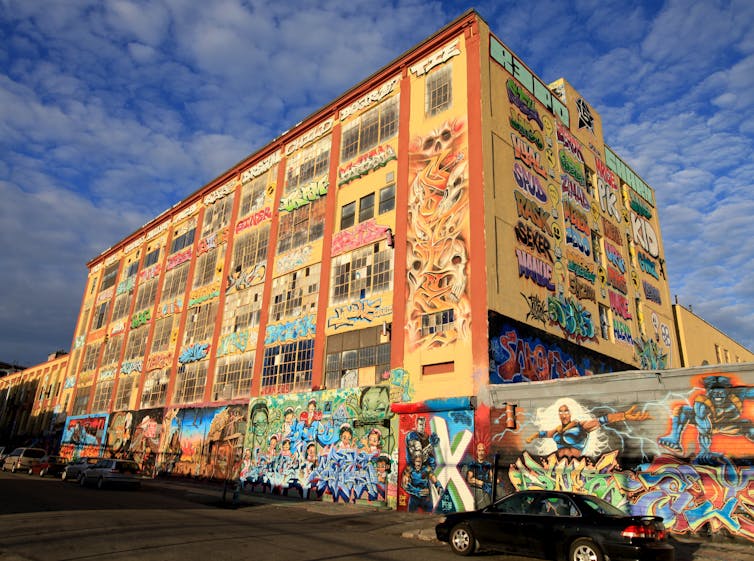Here's a copy of the decision.
At The Conversation, art law expert Leila Amineddoleh writes,
In the 1990s, the developer of Long Island City’s 5Pointz industrial site permitted graffiti artists to paint on the walls, creating a space for them to display their works and to discourage illegal vandalism. The complex became a mecca for graffiti art. Its reputation grew, with tourists visiting the site and international street artists adding to the walls. But in 2010 – in order to capitalize on Long Island City’s rising real estate prices – the owner decided he wanted to redevelop the site as a residential complex. This meant demolishing the buildings, and he received a permit to do so.
On Oct. 10, 2013, 17 artists sought a court order to prevent the demolition, invoking their rights under VARA. One week later, the Eastern District Court issued a temporary restraining order prohibiting the owner from altering the building. It was lifted the following month, partly due to what the judge called the “transient nature” of the works. On Nov. 19, 2013, 5Pointz was whitewashed without any notification given to the artists. The artists sued for violation of VARA.
In November 2017, a jury found that the developer violated VARA, destroying public art of “recognized stature” located on his property. This month, the judge awarded $6.7 million to 21 artists whose works were destroyed in 2013. In prior cases, courts determined whether works were “recognized” by considering the opinions of art experts, members of the artistic community or a cross-section of society. This is the first instance in which graffiti was found to be of “recognized stature.”

The burden to a landowner may seem heavy. It isn’t. Owners aren’t required to maintain the art indefinitely. VARA requires a property owner only to provide artists with a 90-day notice of destruction so that artists may remove the works. In this case, the developer simply didn’t provide the artists 90 days.
Ultimately, this case is a cautionary tale to landowners. Once permission to use private property is granted, the landowner may be prohibited from destroying the work for a set period.
Nonetheless, it’s remarkable that street art has reached a level of “recognized stature.” The role of a court in art law matters is not to pass judgments on the quality of art, but rather to protect all art with rights guaranteed under U.S. law. The jury wisely acknowledged changes in our visual landscape and the need to protect new and evolving styles and genres of art.
But while this might sound like a major victory for artists, the decision in the 5Pointz litigation may also harm them. With the burden to protect art, landowners may be hesitant to permit artists to create works on their property. Owners don’t want any limitations on their property rights. Moving forward, landowners will justifiably be cautious, and may even require artists to sign agreements waiving their VARA rights.
Of course, American novelist Norman Mailer knew art when he saw it forty years ago:
Kurlansky, Mervyn, and Naar, Jon, The Faith of Graffiti (Alskog Books/Praeger Publishers, 1st ed., 1st printing, 1974). ISBN 0-275-71610-0. Paperback, folio-sized collection of photos of New York’s early 1970s graffiti explosion. Novelist Norman Mailer explains The Meaning of It All in a sixteen-page essay mid-book, first published in Esquire in 1974. Good condition, unpaginated. Rare pop culture record. HBB price: $40 obo.
A 2014 New York museum show recalled graffiti’s journey from public nuisance to art form:
‘The centerpiece of “The Faith in Graffiti” is a meandering essay by Norman Mailer. Assuming the identity of “A-1,” Mailer the journalist went into the ghetto to get down with artists like JUNIOR 161, who told him: “You want to get your name in a place where people don’t know how you could do it, how you could get up there.” Mailer the art historian compared CAY 161 and TAKI 183 to Giotto and Michelangelo, to de Kooning and Rauschenberg. He portrayed graffiti artists as part noble savages, part urban gardeners who made rain forests of lettering grow over the monotonous iron-gray brick, concrete and asphalt prisons they were forced to inhabit.
‘Mailer the celebrity chronicled his visit to otherwise-liberal Mayor John Lindsay (whose job he coveted) and tried to get him to reveal why he allowed so much ugly architecture that deserved to be painted over to proliferate during his tenure and why he called the graffiti writers “insecure cowards.” Before he showed Mailer the door, Lindsay explained how much money and effort the city spent on clean, new, air-conditioned subway cars, only to see them defaced.
‘A whole industry grew up around fencing train yards and other potential sites, developing graffiti-proof silicon coatings, criminalizing the purchase of spray paint, and arresting the artists and making them scrub off each others’ work. At the same time, the work of artists including Jean-Michel Basquiat and Keith Haring, was discovered by the media and art magazines, coveted by private collectors, and featured in museum and gallery exhibitions.
‘Flash-forward 40 years. “City as Canvas: Graffiti Art from the Martin Wong Collection,” opened at the Museum of the City of New York on February 4, 2014. In the three weeks since then—even with New York’s worst winter weather in recent history making transportation difficult—thousands of of visitors have come to see (and be photographed with) 150 works of 1970s and ’80s graffiti art, including sketchbooks and mixed-media works on canvas, cardboard, paper and plywood.
‘According to Sean Corcoran, the museum’s curator of prints and photographs, the exhibit is so popular because “people can identity and relate. They feel a bit of ownership. Especially people who grew up with ’80s music, fashion and films like Style Wars.”’


No comments:
Post a Comment
We enjoy hearing from visitors! Please leave your questions, thoughts, wish lists, or whatever else is on your mind.